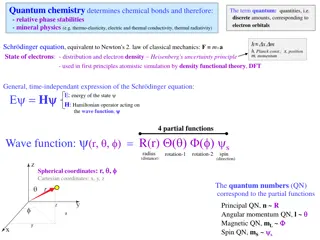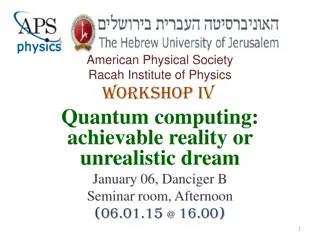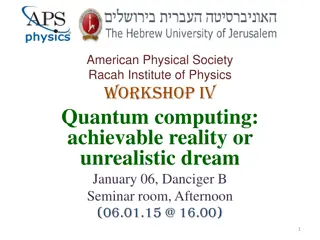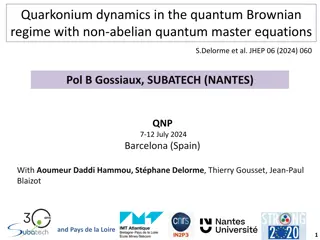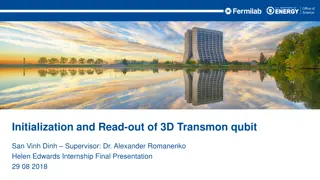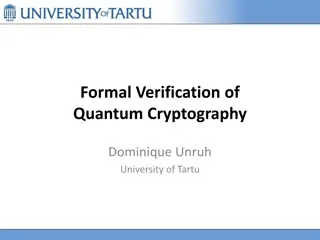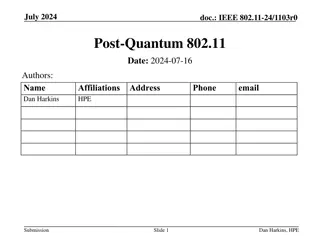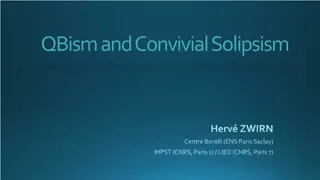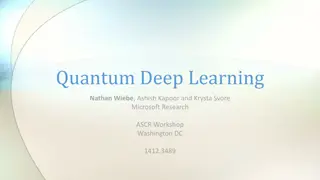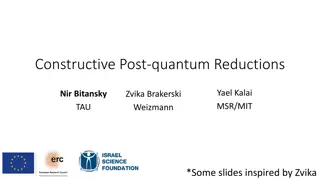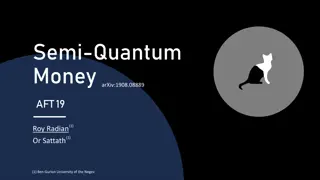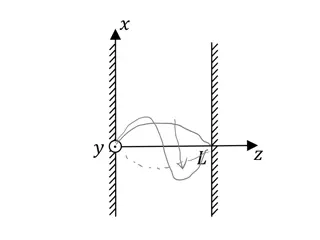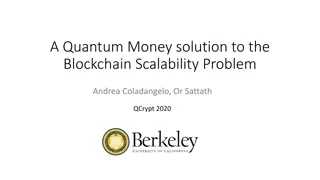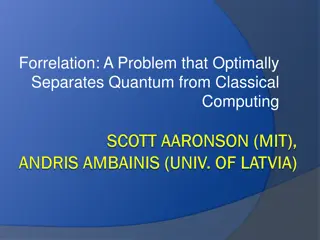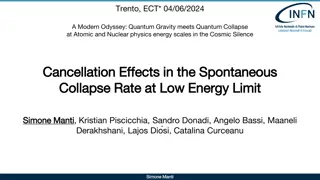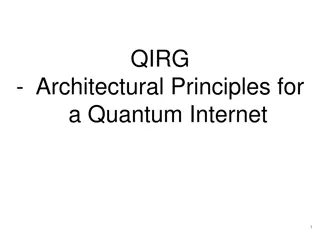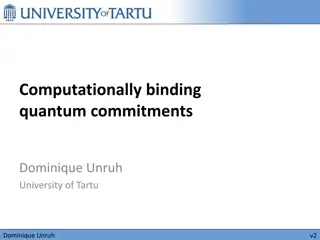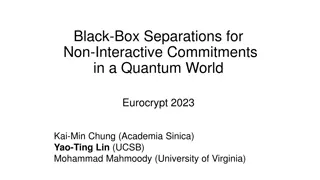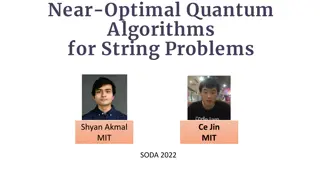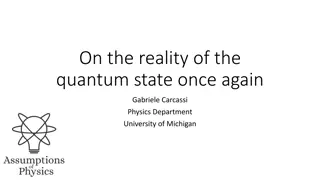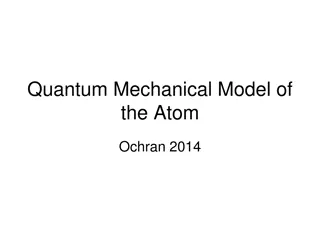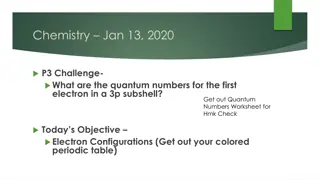Quantum Chemistry Learning Goals and Concepts
This content covers the learning goals and concepts of quantum chemistry leading up to the Schrodinger equation and potential energy wells, excluding the material on the hydrogen atom introduced later. It explores models of the atom, including observations of atomic spectra, the Bohr model, de Broglie's wave-particle duality, and the development of electron wave models. The Schrodinger equation for hydrogen in polar coordinates and solutions are discussed, along with a reading quiz on Schrodinger equation solutions and electron states.
Download Presentation

Please find below an Image/Link to download the presentation.
The content on the website is provided AS IS for your information and personal use only. It may not be sold, licensed, or shared on other websites without obtaining consent from the author. Download presentation by click this link. If you encounter any issues during the download, it is possible that the publisher has removed the file from their server.
E N D
Presentation Transcript
midterm on Friday, can bring usual 1 pg note sheet and calculator. Learning goals through first 5 sections (to Schrod eq and potential energy wells) of learning goals sheet. Not include stuff from today on hydrogen atom-- section #6 of learning goals. Individual plus group again.-- easier to mark if all perfect 1. Today-- return to models of hydrogen atom Schrodinger model. 2. extension to other atoms & molecules 3. Concept mapping exercise. 1
Models of atom 1.Observe atomic spectra, try to develop model for atom to explain. 2. Bohr model-- particular energy levels. 3. How to justify Bohr model energy levels? 4. deBroglie: maybe electron a wave with =h/pel? Dav. Germer-- it works. 2
5. Rethink atom model. Electron acts like a wave, what should be next step in trying to create an electron wave model of hydrogen atom? a. Come up with an equation that describes the electron wave-- solve to predict shape and properties. b. Figure out how to get de Broglie standing waves that represent multielectron atoms. c. Find the boundary conditions on the electron waves d. Measure energy levels of hydrogen more precisely a. Schrod. equa. 3
the 3 D Schrodinger equation 2 2 2 2 2 2 2 2 2 ( , , , ) ( , , , ) ( , , , ) x y 2 z t x y 2 z t x y 2 z t + + + m x m y m z ( , , , ) x y z t = V [ ( , , )] ( , , ) x y z x y zt i t What is potential V to use for hydrogen atom? ke x V ) ( = 2 = a. ( , , ) 0 V x y z b. x 2 ke ke = ( ) V r = + c. d. ( ) V r r + + 2 2 2 1 / 2 ( ) x y z ans. c 4 = r
Schrodinger eq for Hydrogen, polar coordinates r 2 Zke = ( ) V r Define potential energy: r r 2 1 2 r 2 2 r r Use S s Eqn and find solutions: 2 2 2 1 1 + + ) = E sin ( V r 2 2 2 sin sin r z r y x 5
Reading quiz-- answers graded on correctness, no talking 1. Solutions to Schrodinger eq. for hydrogen atom are characterized by a. a single integer, b. 2 integers, c. 3 integers, c. 4 integers d. 5 integers ans. 3. n,l,m 2. The energy corresponding to a solution depends on a. all three integers n,l,m b. only l and m c. n, l d. only l, e. only n. 3. An electron in the 2 p state has a. spherically symmetric probability density b. significant probability of being at the nucleus c. both of the above d. neither of the above 6
Schrodinger eq for Hydrogen, polar coordinates r 2 Zke = ( ) V r Define potential energy: r r 2 1 2 r 2 2 r r Use S s Eqn and find solutions: 2 2 2 1 1 + + ) = E ) sin ( V r = 2 2 2 sin sin r ( , , ) ( ( ) ( ) r R r f g Apply boundary conditions on in terms of r, Messy and tedious but straightforward-- lots of books-- get solution in terms of R, f, gfunctions. ( ) , , ( nl nlm r R r = ) ( ) ( ) f g lm m 7
a. I remember these from chemistry, but not details. b. have never seen before. c. I remember these functions, and what the energy and angular momentum of electron in different wave functions depend on. 8
What do the wave functions look like? , , ( nlm r = ) ( ) ( ) ( ) R r f g nl lm m r = /( ) r na 1 L ( ) R r a e r 0 0 nl nl Laguerre polynomials a 0 + | | l m | | m (sin ) d = ) 1 2 l ( ) (cos f lm l 2 ! (cos ) l d ( = im z ) g e m Messy functions!! Infinite number of solutions, labeled by integers, n,l,m Bunch of facts on conditions on n,l,m and shapes of n,l,m in book. r y 9 x
Boundary conditions: Lead to restrictions on wave functions Lead to quantization in angular momentum and energy = ( , , ) ( ) ( ) ( ) r R r f g nlm nl lm m n=1, 2, 3 = Principle Quantum Number 2 1/n E En = n=2 (for Hydrogen, same as Bohr) 2p l=0, 1, 2, 3 = Angular Momentum Quantum Number =s, p, d, f (restricted to 0, 1, 2 n-1) ) 1 ( | | + = l l L l=1 m = ... -1, 0, 1.. = z-component of Angular Momentum (restricted to lto l) m Lz= m=-1,0,1 10
Energy Diagram for Hydrogen l=0 (s) l=1 (p) l=2 (d) n=3 3s 3p 3d n=2 Energy only depends on n (NOT true for hydrogen if look more carefully-- improved solution, including magnetic effects-- important triumph of Sch. Eq.). Completely wrong for multi- electron atoms. 2s 2p n=1 l=0,m=0 1s 11
An electron in the Hydrogen atom is excited to the following electronic state: = ( n ( , , ) ( ) ( ) ( ) r R r 10 f g , 3 = , 1 = = 0 31 0 n l m )2 = = with energy . 3 = En / 3 E 1 How many electronic energy levels have the same energy as this one? (a) 1 (b) 2 (c) 3 (d) 5 (e) 9 12
Comparing H atom & Infinite Square Well: Infinite Square Well: (1D) V(x) = 0 if 0<x<L otherwise H Atom: (3D) V(r) = -Zke2/r r x 0 L Energy eigenstates: mZ En = Energy eigenstates: n En = 2 2 4 k e 2 2 2 2 2 2 n 2 2mL Wave functions: ) , , ( nlm r = Wave functions: ) ( = ( ) ( ) ( ) R r f g n x sin( ) nx 2 L nl lm m L = / iE t ( , , , ) ( , , ) r t r e = / iE t ( , ) ( ) n x t x e n 13 nlm nlm n n
Schrodinger finds quantization of energy and angular momentum: l=0, 1, 2, 3 (restricted to 0, 1, 2 n-1) ( | | + = l l L n=1, 2, 3 E En = 2 1/n ) 1 How does Schrodinger compare to what Bohr thought? I. The energy of the ground state solution is ________ II. The angular momentum of the ground state solution is _______ III. The location of the electron is _______ a. same, same, same b. same, same, different c. same, different, different d. different, same, different e. different, different, different 14
Schrodinger finds quantization of energy and angular momentum: l=0, 1, 2, 3 (restricted to 0, 1, 2 n-1) ( | | + = l l L n=1, 2, 3 E En = 2 1/n ) 1 How does Schrodinger compare to what Bohr thought? I. The energy of the ground state solution is ________ 2 1/n same same: for both (E1=-13.6eV) E En = II. The angular momentum of the ground state solution is _______ Schrodinger: Ground state (n,l,m = 1,0,0) so L=0 (Bohr and deBroglie were wrong) different Bohr and deBroglie said: L=nh, so L=h in ground state. different III. The location of the electron is _______ Schrodinger: spread out as spherical cloud around nucleus Bohr said: orbiting as point particle at fixed radius deBroglie said: spread out as wave, but confined to fixed radius (Both wrong) 15 Schrodinger s solution does everything that Bohr s could not!
Here are 3 different electronic state in the hydrogen atom ( ) , , ( 4 , 5 4 , 4 , 5 r R r m l n = 1 ) ( ) ( ) 4 , 4 f g = = = 4 = 2 ( , , ) ( ) ( ) ( ) r R r f g = = = 45 , 44 , 44 n l m 45 , 44 r 44 44 ) , 44 = 3 ( , , ) ( ) ( ( ) r 0 , 1 R 0 , 1 f g , 1 = , 0 = = 0 n l m 0 = ) 1 + | | ( L l l (orbital angular momentum ). If you could look at the probability density Vs time for the 3 wavefunctions above, which ones would move around in space the most rapidly? Rank the 3 wavefunctions (1,2, and 3) from slowest to fastest motion: (a) 1 slowest then,2,3 (b) 3,1,2 (c) 3,2,1 (d) 2,3,1 (e) All three are the same 16
e) all the same-- not changing! When in single energy eigenstate, which all these states are, no time dependence in probability distribution. See sim. Remember last Friday, only mixtures of different energy eigenstates give interference term that gives time dependence. So have angular velocity-- going around the nucleus, but probability distribution does not change. Angular momentum is represented by phase in the angular wave function, just like kinetic energy, by spatial variation in wave function. m=1 17
PLUS Schrodingers also works for multi-electron atoms Easy to describe, hard to solve. What s different for these cases? Potential energy (V) changes! More protons AND other electrons) V (for q1) = kqnucleusq1/r1 + kq2q1/r2-1 + kq3q1/r3-1+ . +V(for q2) +V(q3), ... Need to account for all the interactions among the electrons Must solve for all electrons at once! ( 1, 2, 3, 4, ...) Clever approximations and big computer programs! Solutions change: different shaped wave functions higher Z more protons electrons in 1s more strongly bound radial distribution quite different general shape (p-orbital, s-orbital) similar but not same! - energy of wave functions affected by Z (# of protons) higher Z more strongly bound (more negative total energy) 18 Molecules-- same physics and equa. but even messier to solve
models of hydrogen (and other atoms) 1. Thompson- plum pudding 2. Rutherford solar system 3. Bohr 4. de Broglie standing waves 5. Schrodinger-- 6. Schrodinger with electron spin added good for almost everything that matters, to ~ 6 digits used for all normal day to day physics 7. Dirac -- spin and relativity, negative energy states 8. Quantum electrodynamics (quantum field theory) 9. Electroweak unification 10. Grand unification??? 20
Concept map-- way to think about what are the most important ideas and concepts, and how they fit together. Experts do all the time. Good for pulling together all the stuff we covered and getting it organized in your mind. quite simple map Brainstorm for ~5 minutes-- list of important idea ( brainstorm , just throw out ideas, don t waste time arguing, do that later.) Then decide which belong on list, lay out on map with links. Then mark the 6 ovals that are THE 6 MOST IMPORTANT ideas. Sketch out practice map on small paper. Then do final one on large paper with group number. 12:00 post. Everyone has to rank the maps of at least 4 other groups, with brief reasons why ranking, turn in ranking sheets. 3 points for ranking sheet. 21
Physics vs Chemistry view of orbits: Dumbbell Orbits (chemistry) 2p wave functions (Physics view) (n=2, l=1) px py pz m=1 m=-1 m=0 px=superposition (addition of m=-1 and m=+1) py=superposition (subtraction of m=-1 and m=+1) 22







